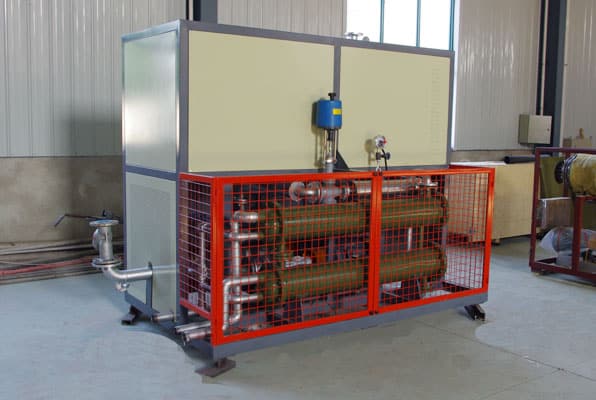Introdução
In high-risk industries such as chemicals and lithium batteries, explosion-proof electric thermal oil heaters, as critical thermal energy equipment, directly impact production line stability and personnel safety. With increasingly stringent national industrial safety requirements, designing thermal oil heaters that comply with the latest explosion-proof standards has become a key concern for equipment manufacturers and end-users. This article provides an in-depth analysis of the design essentials of explosion-proof electric thermal oil heaters and interprets the specific safety standards for the chemical and lithium battery industries, offering technical insights for the sector.
1. Core Design Principles of Explosion-Proof Electric Thermal Oil Heaters
(1) Explosion-Proof Classification
According to GB 3836 (equivalent to IEC 60079), explosion-proof equipment must specify the following parameters:
- Classification of Explosive Atmospheres:
- Zone 0/1/2 (gas environments)
- Zone 20/21/22 (dust environments)
- Equipment Protection Level (EPL):
- Ga/Gb/Gc (gas)
- Da/Db/Dc (dust)
Chemical Industry: Typically requires EPL Gb (Zone 1) or higher
Lithium Battery Industry: Must meet both Gb (solvent vapor) and Db (electrode dust) requirements
(2) Key Explosion-Proof Design Points
| Design Aspect | Technical Requirements | Industry Example |
|---|---|---|
| Electrical System | Flameproof (Ex d) or Increased Safety (Ex e) | Chemical reactor heating |
| Heating Elements | Armored resistance wire + magnesium oxide insulation, surface temperature ≤ T6 class (85°C) | Lithium electrode drying |
| Control System | Intrinsic safety circuit (Ex ia/ib), grounding resistance <4Ω | Solvent recovery unit |
| Mechanical Structure | Flange sealing, housing withstands 1.5x design pressure | Polymer reaction system |
2. Special Requirements and Solutions for the Chemical Industry
(1) Corrosion-Resistant Design
- Material Selection:
- 316L stainless steel housing (for chloride ion corrosion resistance)
- Hastelloy C-276 heating tubes (for strong acid environments)
- Sealing Technology:
- Double-layer metal spiral gaskets (pressure-resistant up to 10MPa)
- Fully welded structure (to prevent flange leakage)
(2) Safety Interlocks
- Triple Protection Mechanism:
- Redundant temperature sensors (PT100 + thermocouple)
- Pressure switch and flow meter linkage shutdown
- SIL2-certified Safety Instrumented System (SIS)
Case Study: A petrochemical PX unit thermal oil system, ATEX-certified
3. Special Challenges and Solutions for the Lithium Battery Industry
(1) Dust Explosion Protection (Per GB 12476)
- Dust Accumulation Prevention:
- Surface temperature ≤ 2/3 of dust cloud ignition temperature
- Inclined design (dust accumulation angle ≥45°)
- Static Elimination:
- Conductive coating (surface resistance <1×10⁶Ω)
- Ionized air curtain (for dust-prone areas)
(2) Solvent Vapor Protection
- Concentration Monitoring:
- Online LEL detectors (alarm at 20% of lower explosion limit)
- Positive pressure purging system (N₂ inerting)
Industry Application: Electrode drying ovens for a top 10 battery manufacturer, compliant with ANSI/UL 674
4. Latest Regulatory Updates and Compliance Recommendations
(1) Domestic and International Standard Revisions
渲染失败
5. Future Technology Trends
- Smart Explosion Protection:
- AI-based leak prediction systems
- Real-time digital twin simulations
- New Material Applications:
- Silicon carbide heating tubes (withstands 1500°C)
- Self-healing insulation coatings
- Green Safety:
- Phase-change heat storage replacing resistive heating
- Hydrogen-powered thermal oil heater pilots
Conclusão
The design of explosion-proof electric thermal oil heaters must address the three elements of explosion (fuel, oxygen, ignition source) while incorporating industry-specific risks for chemicals and lithium batteries. For equipment selection, we recommend:
✅ Prioritize products with dual CNEX/ATEX certification
✅ Request HAZOP analysis reports from suppliers
✅ Conduct quarterly inspections of explosion-proof components
Need an Explosion-Proof Thermal Oil Heater Selection Guide? Contact us for industry-tailored solutions!

